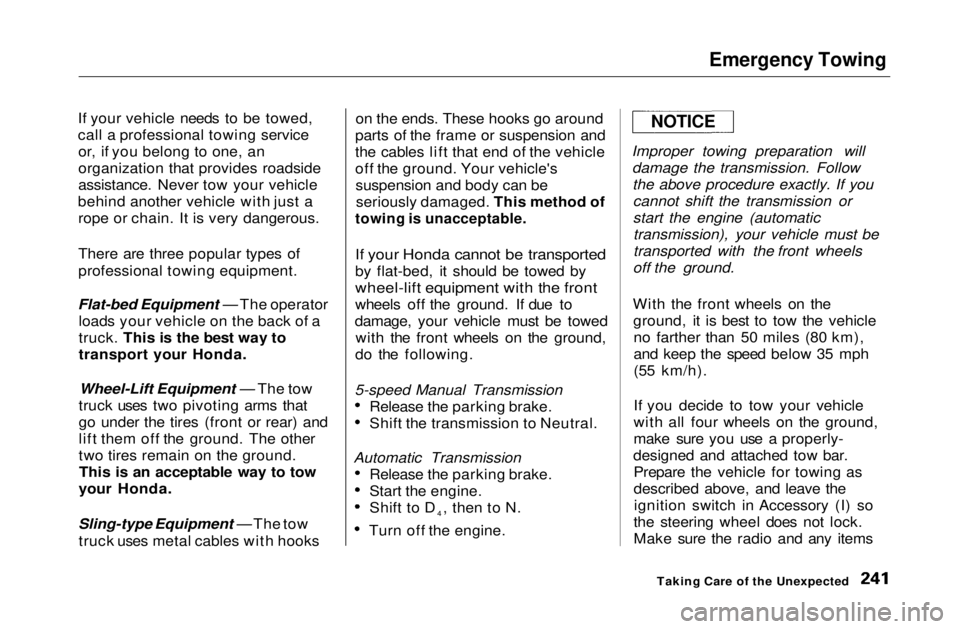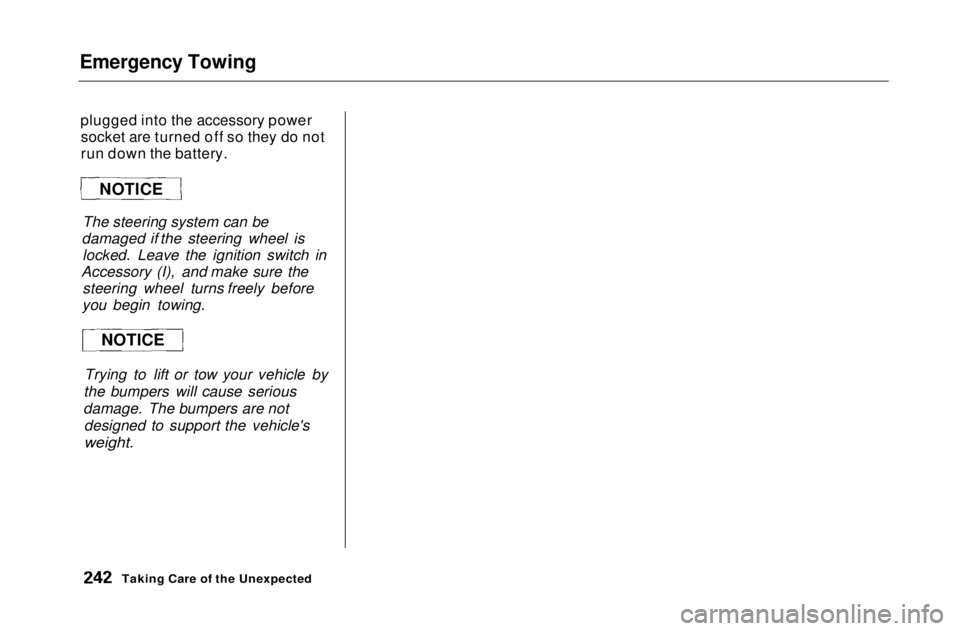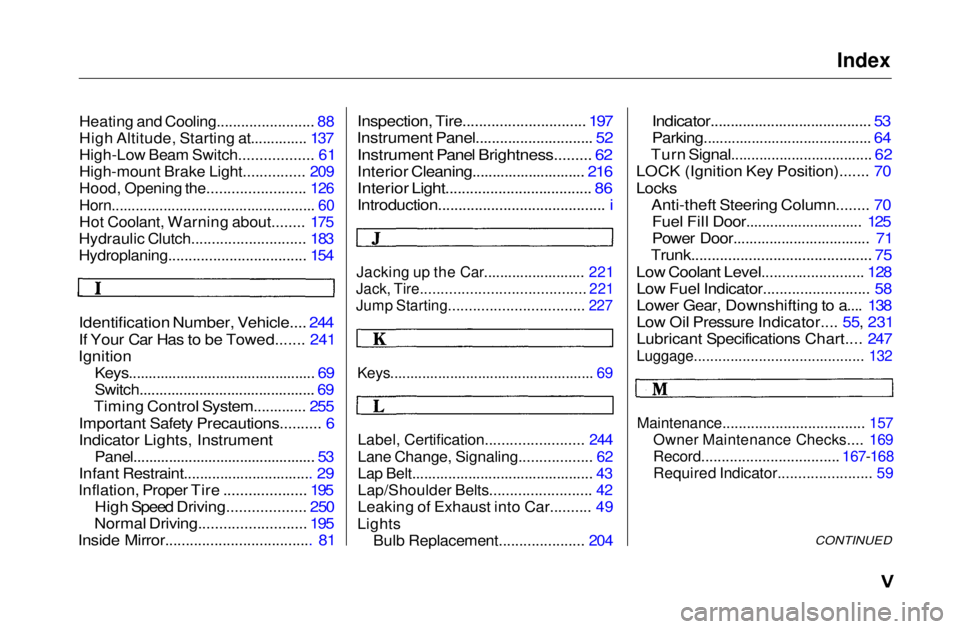1999 HONDA CIVIC COUPE ignition
[x] Cancel search: ignitionPage 236 of 269

Fuses
Vehicles equipped with ABS have a third fuse box for the ABS. It is in
the engine compartment on the
passenger's side.
Checking and Replacing Fuses
If something electrical in your car stops working, the first thing you
should check for is a blown fuse.
Determine from the chart on pages 198 and 199, or the diagram on the
fuse box lid, which fuse or fuses control that component. Check those
fuses first, but check all the fuses
before deciding that a blown fuse is not the cause. Replace any blown
fuses and check the component's
operation.
1. Turn the ignition switch to LOCK (0). Make sure the headlights and
all other accessories are off.
2. Remove the cover from the fuse box. FUSE
3. Check each of the large fuses in the under-hood fuse box by
looking through the top at the wire
inside. Removing these fusesrequires a Phillips-head screw-
driver.
CONTINUED
Taking Care of the Unexpected
ABS FUSE BOX
BLOWNMain Menu Table of Contents s t
Page 240 of 269

Emergency Towing
If your vehicle needs to be towed,
call a professional towing service or, if you belong to one, an
organization that provides roadside
assistance. Never tow your vehicle
behind another vehicle with just a rope or chain. It is very dangerous.
There are three popular types of
professional towing equipment.
Flat-bed Equipment — The operator loads your vehicle on the back of a
truck. This is the best way to
transport your Honda.
Wheel-Lift Equipment — The tow
truck uses two pivoting arms that
go under the tires (front or rear) and
lift them off the ground. The other
two tires remain on the ground. This is an acceptable way to tow
your Honda.
Sling-type Equipment — The tow truck uses metal cables with hooks on the ends. These hooks go around
parts of the frame or suspension and
the cables lift that end of the vehicle
off the ground. Your vehicle's suspension and body can beseriously damaged. This method of
towing is unacceptable.
If your Honda cannot be transported
by flat-bed, it should be towed by
wheel-lift equipment with the front
wheels off the ground. If due to
damage, your vehicle must be towed with the front wheels on the ground,
do the following.
5-speed Manual Transmission Release the parking brake.
Shift the transmission to Neutral.
Automatic Transmission Release the parking brake.
Start the engine.
Shift to D4, then to N.
Turn off the engine. Improper towing preparation will
damage the transmission. Followthe above procedure exactly. If youcannot shift the transmission or
start the engine (automatictransmission), your vehicle must be
transported with the front wheels
off the ground.
With the front wheels on the ground, it is best to tow the vehicleno farther than 50 miles (80 km),
and keep the speed below 35 mph
(55 km/h).
If you decide to tow your vehicle
with all four wheels on the ground,
make sure you use a properly-
designed and attached tow bar. Prepare the vehicle for towing as
described above, and leave theignition switch in Accessory (I) so
the steering wheel does not lock.
Make sure the radio and any items
Taking Care of the Unexpected
NOTICEMain Menu Table of Contents s t
Page 241 of 269

Emergency Towing
plugged into the accessory powersocket are turned off so they do not
run down the battery.
Trying to lift or tow your vehicle by
the bumpers will cause serious
damage. The bumpers are not designed to support the vehicle's
weight.
Taking Care of the Unexpected
The steering system can be
damaged if the steering wheel is locked. Leave the ignition switch in
Accessory (I), and make sure the steering wheel turns freely before
you begin towing.
NOTICE
NOTICEMain Menu Table of Contents s t
Page 242 of 269

Technical Information
The diagrams in this section give you the dimensions and capacities of
your Honda, and the locations of the identification numbers. The expla-
nations of several electronic and
mechanical systems on your Honda
are for the more technically-oriented
owner. Identification Numbers................. 244
Specifications................................. 246
Tire Information............................ 249 Tire Size Designation................ 249
Wheel Size Designation............ 249
Tire Speed Ratings.................... 249
Tire Pressure Adjustment For High Speed Driving............... 250
DOT Tire Quality Grading....... 250
Treadwear.............................. 250
Traction.................................. 251Temperature.......................... 251
Oxygenated Fuels.......................... 252
Driving in Foreign Countries....... 253 Emissions Controls........................ 254
The Clean Air Act...................... 254Crankcase Emissions Control System..................................... 254
Evaporative Emissions Control System..................................... 254
Onboard Refueling Vapor Recovery................................. 254
Exhaust Emissions Controls.... 255 PGM-FI System..................... 255
Ignition Timing ControlSystem................................. 255
Exhaust Gas Recirculation (EGR) System.................... 255
Three Way Catalytic Converter............................ 255
Replacement Parts..................... 255
Three Way Catalytic Converter... 256
Technical InformationMain Menu s t
Page 254 of 269

Emissions Controls
Exhaust Emissions Controls
The exhaust emissions controls include three systems: PGM-FI,
Ignition Timing Control and Three
Way Catalytic Converter. These three systems work together tocontrol the engine's combustion and
minimize the amount of HC, CO, and
NOx that comes out the tailpipe. Theexhaust emissions control systems
are separate from the crankcase and
evaporative emissions control
systems.
PGM-FI System
The PGM-FI System uses sequential multiport fuel injection.
It has three subsystems: Air Intake,Engine Control, and Fuel Control.
The Engine Control Module (ECM)/ Powertrain Control Module (PCM)/
Transmission Control Module (TCM-HX model only) uses various
sensors to determine how much air
is going into the engine. It then controls how much fuel to inject under all operating conditions.
Ignition Timing Control System
This system constantly adjusts the ignition timing, reducing the amountof HC, CO and NOx produced.
Exhaust Gas Recirculation (EGR) System
Only on HX model
The Exhaust Gas Recirculation (EGR) system takes some of the
exhaust gas and routes it back into
the intake manifold. Adding exhaust
gas to the air/fuel mixture reduces
the amount of NOx produced when
the fuel is burned.
Three Way Catalytic Converter
The three way catalytic converter is in the exhaust system. Throughchemical reactions, it converts HC,
CO, and NOx in the engine's exhaust
to carbon dioxide (CO 2), dinitrogen
(N2), and water vapor. Replacement Parts
The emissions control systems are designed and certified to work to-
gether in reducing emissions to
levels that comply with the Clean Air
Act. To make sure the emissions remain low, you should use only new Genuine Acura replacement parts or
their equivalent for repairs. Using lower quality parts may increase the
emissions from your car.
The emissions control systems are covered by warranties separate from
the rest of your car. Read your
warranty manual for more informa- tion.
Technical InformationMain Menu Table of Contents s t
Page 260 of 269

Index
Accessories and Modifications.... 130 Accessories................................. 130Additional Safety Precaution.... 131 Modifications............................. 131
ACCESSORY (Ignition Key Position)........................................ 70
Accessory Power Socket................ 85
Adding Automatic Transmission
Fluid........................................ 180
Brake Fluid................................. 183 Clutch Fluid................................ 183
Engine Coolant........................... 175
Engine Oil................................... 171
Manual Transmission Fluid..... 182
Power Steering Fluid................. 184
Windshield Washer Fluid......... 180
Additional Information About Your Seat Belts........................ 42
Lap Belt......................................... 43
Lap/Shoulder Belt....................... 42
Seat Belt Maintenance................ 44
Seat Belt System Components... 42 Additional Information About
Your SRS................................... 45
Additional Safety Precautions.... 48 How Your Airbags Work............ 45
How Your SRS Indicator
Works........................................ 47
SRS Components......................... 45
Additives, Engine Oil..................... 171
Adjustments
Head Restraints........................... 77
Mirrors.......................................... 81
Seats.............................................. 76
Steering Wheel............................ 65
Airbag (SRS)...................................... 9
Air Cleaner Element...................... 185 Air Conditioning............................... 88 Maintenance............................... 193
Usage............................................. 90
Air Outlets (Vents).......................... 90
Air Pressure, Tires........................ 196 High Speed Driving................... 250
Normal Driving.......................... 196
Alcohol in Gasoline........................ 252
Antifreeze....................................... 175
Anti-lock Brakes (ABS) Indicator Light.................... 55, 153
Operation.................................... 152
Anti-theft Steering Column
Lock............................................... 70
Appearance Care........................... 213
Ashtrays (Optional)......................... 85
Audio System................................... 96
Automatic Speed Control................ 66
Automatic Transmission............... 140
Capacity, Fluid........................... 247
Checking Fluid Level................ 180
Shifting........................................ 141
Shift Lever Position Indicator.. 140
Shift Lever Positions................. 141
Shift Lock Release..................... 144
Battery Charging SystemIndicator............................ 55, 232
Jump Starting............................. 227 Maintenance............................... 189
Specifications............................. 248
CONTINUEDMain Menu s t
Page 264 of 269

Index
Heating and Cooling........................ 88
High Altitude, Starting at.............. 137
High-Low Beam Switch.................. 61
High-mount Brake Light............... 209
Hood, Opening the........................ 126
Horn................................................... 60
Hot Coolant, Warning about........ 175
Hydraulic Clutch............................ 183
Hydroplaning.................................. 154
Identification Number, Vehicle.... 244
If Your Car Has to be Towed....... 241
Ignition
Keys............................................... 69
Switch............................................ 69
Timing Control System............. 255
Important Safety Precautions.......... 6
Indicator Lights, Instrument
Panel.............................................. 53
Infant Restraint................................ 29
Inflation, Proper Tire .................... 195
High Speed Driving................... 250
Normal Driving.......................... 195
Inside Mirror.................................... 81
Inspection, Tire.............................. 197
Instrument Panel............................. 52
Instrument Panel Brightness......... 62
Interior Cleaning............................ 216
Interior Light.................................... 86
Introduction......................................... i
Jacking up the Car......................... 221
Jack, Tire........................................ 221
Jump Starting................................. 227
Keys................................................... 69
Label, Certification........................ 244
Lane Change, Signaling.................. 62
Lap Belt............................................. 43
Lap/Shoulder Belts......................... 42
Leaking of Exhaust into Car.......... 49
Lights
Bulb Replacement..................... 204
Indicator........................................ 53
Parking.......................................... 64
Turn Signal................................... 62
LOCK (Ignition Key Position)....... 70
Locks
Anti-theft Steering Column........ 70Fuel Fill Door............................. 125
Power Door.................................. 71
Trunk............................................ 75
Low Coolant Level......................... 128 Low Fuel Indicator.......................... 58
Lower Gear, Downshifting to a.... 138
Low Oil Pressure Indicator.... 55, 231
Lubricant Specifications Chart.... 247
Luggage.......................................... 132
CONTINUED
Maintenance................................... 157
Owner Maintenance Checks.... 169
Record.................................. 167-168
Required Indicator....................... 59Main Menu s t
Page 265 of 269

Index
Maintenance
Safety........................................... 158
Schedule.............................. 162-166
Malfunction Indicator Lamp.. 55, 233
Manual Transmission.................... 138
Manual Transmission Fluid ......... 182
Meters, Gauges................................ 57
Methanol in Gasoline.................... 252
Mirrors, Adjusting........................... 81
Moonroof.......................................... 81
Closing Manually....................... 235Operation...................................... 81
Neutral Gear Position.................... 143
New Vehicle Break-in ................... 124
Normal Shift Speeds .............. 139-140
NOTICE, Explanation of.................... i
Numbers, Identification................ 244
Octane Requirement, Gasoline.... 124
Odometer.......................................... 57
Odometer, Trip................................ 57
Oil
Change, How to......................... 173
Change, When to....................... 162
Checking Engine....................... 127
Pressure Indicator............... 55, 231 Selecting Proper Viscosity Chart....................................... 172
ON (Ignition Key Position)............ 70
Opening the Hood......................... 126
Opening the Trunk.......................... 75 Operation in Foreign Countries... 253
Outside Mirrors............................... 81
Overheating, Engine..................... 229
Panel Brightness Control............... 62 Park Gear Position......................... 141
Parking............................................ 149
Parking Brake.................................. 82
Parking Lights.................................. 64
Parking Over Things that Burn... 255
PGM-FI System.............................. 255
Polishing and Waxing................... 214
Power
Door Locks................................... 70
Mirrors.......................................... 81
Steering....................................... 184
Windows....................................... 79
Pre-Drive Safety Checklist............. 11
Pregnancy, Using Seat Belts.......... 19
Protecting Adults............................. 12
Additional Safety Precautions.... 19
Advice for Pregnant Women...... 19
Protecting Children......................... 21 Protecting Infants........................ 29
Protecting Larger Children........ 37
Protecting Small Children.......... 33
Using Child Seats withTethers...................................... 40
Radiator Overheating.................... 229
Radio/Cassette Sound System....... 96
Rear End Towing........................... 241
Rear Lights, Bulb Replacement... 206
Rear Seat, Folding........................... 78
Rear View Mirror............................. 81
Rear Window .................. 64Main Menu s t